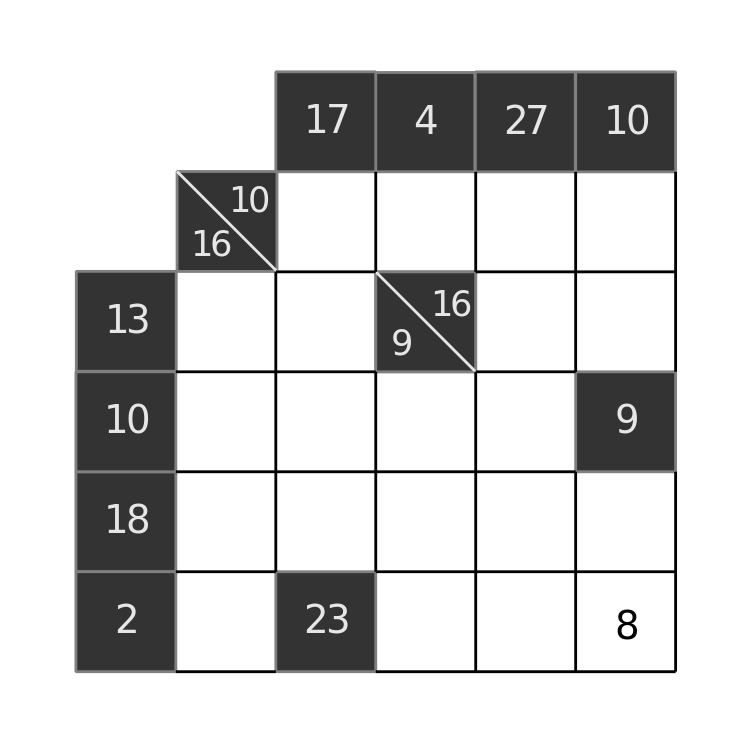The Kakuro puzzle is a kind of logic puzzle that is often referred to as a mathematical transliteration of the crossword. It resembles Sudoku which is nowadays more popular. Kakuro puzzles can be found in newspapers (e. g. Dagens Nyheter and Svenska Dagbladet in Sweden) as well as in hobby magazines. Kakuro puzzles are hard to solve for the the beginner but becomes easier with training.
A Kakuro puzzle consists of a rectangular grid of empty cells which are to be filled with integers in the interval [1, 9]. Other cells contain row and/or column conditions. A row condition gives the sum which the empty cells to the right of it must add up to, and a column condition shows the required sum of the empty cells immediately below. Duplicates are not allowed in these sums.
A small example:

We number the rows from 0 to 5, and the columns also from 0 to 5. The contents of the empty cells of row 1 we call c12,...,c15. Row 1 has the associated condition that the sum of its four cell values should equal 10. Row 2 has two conditions:
13 = c22 + c23 and 16 = c24 + c25
Column 2 carries two conditions, the first of which is 4 = c12. And so on. The value of c55 is given explicitly as 8.
It would seem that the puzzle is defined by a system of linear equations. However added requirements of every cij being in the range 1..9, and that every term in a sum being different, makes it necessary to look for another approach:
Locate a row or column condition which can be satisfied in a minimum number of alternative ways! Cross your fingers and choose one of these. Then continue in the same way. In general back-tracking is necessary, of course. (The general kakuro puzzle problem has been shown to be NP-complete, that is, inherently difficult.)
The example problem above is rather easily solved by hand. Hint: the sum 23 on the last row can only be obtained in two ways. Looking at the associated column conditions one of them can be eliminated. Our example has two solutions. As a rule, published kakuro puzzles have a unique solution.
There exist variations of Kakuro. One popular form has the added condition that some cells are grey instead of white. The grey cells are to be filled with odd numbers and the white ones with even numbers. We call these puzzles "parity kakuro" puzzles. Solving kakuro puzzles by hand is is an interesting pastime. Writing a computer program solving any puzzle is still more intriguing. Working on the problem I learnt a programming language new to me: Python
The idea of the program is to follow the approach outlined above, using the computer to keep track of all choices, allowing correct backtracing if a choice turns out to lead to a dead end - not an easy task. Puzzles of size 10 x 10 can be difficult for a human but are solved in a fraction of a second by the computer. (Note. The program can in rare cases make a suboptimal choice. Example: Dividing 9 into two parts can be done in 8 ways, and dividing 23 into three parts can be done in 6 ways. The program always chooses a condition among those with a minimum of empty cells. This does not mean that the program is erroneous.)
Input to the program is a text file where the row and column conditions are enumerated as well as the given cells. For the example, the text file looks as follows (r indicating a row condition, c a column condition, and b a board position):
r1 10 2:5 (i e, 10 = c12+c13+c14+c15) r2 13 1:2 r2 16 4:5 r3 10 1:4 r4 18 1:5 r5 2 1 r5 23 3:5 c1 16 2:5 (i e, 16 = c21+c31+c41+c51) c2 17 1:4 c3 4 1 c3 9 3:5 c4 27 1:5 c5 10 1:2 c5 9 4:5 b 5 5 8 ( i e, c55 = 8) .
A convenient graphical user interface is not implemented: my interest was to develop a correct solver.
Given this input file the program computes and prints the solution(s). The program library published here as a "7zip" file contains three versions, one for the standard kakuro, one verbose version for standard kakuro, and one for parity kakuro. The verbose version produces a trace showing what is going on during the computation. This trace can be long!
In case of a parity kakuro the input must enumerate the even cells - those not enumerated are considered to be odd. This is done by adding one or more lines beginning with an 'e'. For example, a 2 by 2 checkerboard where c12 and c21 should be odd would require the added line:
e 11 22
The program has been tested on Windows and Linux using the examples provided with kaklib. We assume that Python version 3 has been installed, and that kaklib.7z has been downloaded and unpacked into the folder kaklib.
On Windows:from os import * to get access to the functions getcwd, chdir, listdir to move to the kaklib folder and list its files.chdir('C:\\Users\le\Documents\kaklib'))
from kaksolve import kaksolvefrom kaksolvev import kaksolve for the verbose version, or
from kaksolvep import kaksolve for running a parity problem)
mini0.txt, run kaksolve("Ex\mini0.txt")kaksolve("Ex\mini0.txt", 2) will provide most information. IDLE).
On Linux:
Start a terminal window and move to the kaklib directory. Startpython3. For running an example follow points 3 and 4 above. The text editors gedit and kate (for example) are helpful for editing .py files.
Any feedback would be most welcome!
5 Sep 2013
Lars-Erik Thorelli